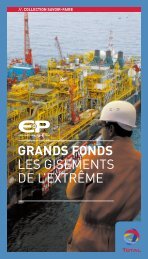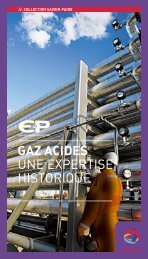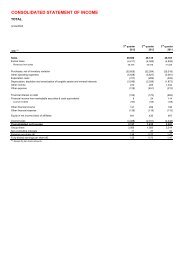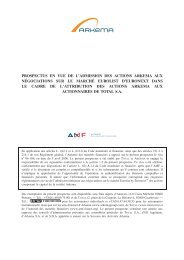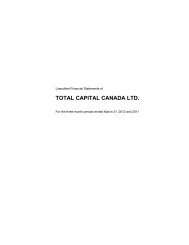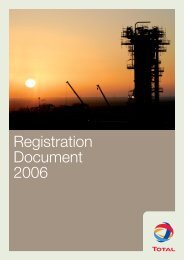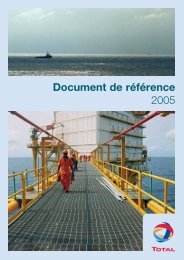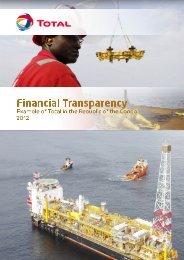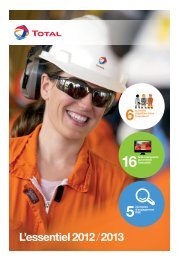Registration Document 2005 - Total.com
Registration Document 2005 - Total.com
Registration Document 2005 - Total.com
Create successful ePaper yourself
Turn your PDF publications into a flip-book with our unique Google optimized e-Paper software.
4<br />
Risk factors<br />
Industrial and environmental risks<br />
Industrial and environmental risks<br />
Types of risks<br />
TOTAL’s activities present industrial and environmental risks which<br />
are inherent in the production of products that are flammable,<br />
explosive or toxic. Its activities are therefore subject to extensive<br />
government regulations concerning environmental protection<br />
and industrial security in most countries. For example, in Europe,<br />
TOTAL operates sites that meet the criteria of the European Union<br />
Seveso II directive for classification as high-risk sites. Other sites<br />
operated by TOTAL in other parts of the world involve similar risks.<br />
The broad scope of TOTAL’s activities, which include drilling, oil<br />
and gas production, on-site processing, transportation, refining,<br />
petrochemicals activities, storage and distribution of petroleum<br />
products, production of intermediary chemical products and<br />
specialty chemicals, involve a wide range of operational risks.<br />
Among these risks are those of explosion, fire or leakage of toxic<br />
products. In the transportation area, the type of risks depends<br />
not only on the hazardous character of the products transported,<br />
but also on the transportation methods used (mainly pipelines,<br />
maritime, river-maritime, rail, road) and the volumes involved.<br />
Most of these activities involve environmental risks related to air<br />
or water emissions and the creation of waste, and also require<br />
environmental site restoration after production is discontinued.<br />
Certain branches or activities face specific risks. In oil and gas<br />
exploration and production, there are risks related to the physical<br />
characteristics of an oil or gas field. These include eruptions of<br />
crude oil or of natural gas, discovery of hydrocarbon pockets<br />
with abnormal pressure, crumbling of well openings, hydrocarbon<br />
leaks generating toxic risks and risks of fire or explosion. All<br />
these events could possibly damage or even destroy crude oil or<br />
natural gas wells as well as related equipment and other property,<br />
cause injury or even death, lead to an interruption of activity or<br />
cause environmental damage. In addition, since exploration and<br />
production activities may take place on sites that are ecologically<br />
sensitive (tropical forest, marine environment, etc.), each site<br />
requires a specific approach to minimize the impact on the related<br />
ecosystem, biodiversity and human health.<br />
TOTAL’s activities in the Chemicals segment and, to a lesser<br />
extent, the Downstream segment also have related health, safety<br />
and environmental risks. These risks can arise from the intrinsic<br />
characteristics of the products involved, which may, for example, be<br />
flammable, toxic, or be linked to the greenhouse gas effect. Risks<br />
of facility contamination and off-site impacts may also arise from<br />
emissions and discharges resulting from processing or refining, and<br />
from recycling or the disposal of materials or wastes at the end of their<br />
useful life.<br />
84 TOTAL - <strong>Registration</strong> <strong>Document</strong> <strong>2005</strong><br />
Risk evaluation<br />
Prior to developing their activities and then on a regular basis during<br />
the operations, business units evaluate through specific procedures<br />
the related industrial and environmental risks in addition to taking<br />
into account the regulatory requirements of the countries where<br />
these activities are located.<br />
On sites with significant technological risks, analyses are performed<br />
for new developments, updated in case of planned significant<br />
modifications of existing equipment, and periodically re-evaluated.<br />
To harmonize these analyses and reinforce risk management,<br />
TOTAL has developed a group-wide methodology which is being<br />
implemented progressively throughout the sites it operates. In<br />
France, three pilot sites are developing Risk Prevention Plans<br />
in application of the French law of July 30, 2003. These Risk<br />
Prevention Plans will implement various urbanization measures in<br />
order to reduce risks to urban environments surrounding industrial<br />
sites. The texts implementing these aspects of the law of July 30,<br />
2003 were published at the end of <strong>2005</strong>.<br />
Similarly, environmental impact studies are done prior to any<br />
industrial development with a specific, thorough initial site analysis<br />
taking into account any special sensitivities. These studies also<br />
take into account the impact of the activities on the health of the<br />
neighboring population. These studies are based on a <strong>com</strong>mon<br />
methodology. In countries where prior authorization and supervision<br />
is required, the projects are not undertaken without informing the<br />
relevant authorities of the studies.<br />
For new products, risk characterizations and evaluations are<br />
performed. Furthermore, Life Cycle Analyses (ACV) for related<br />
risks are performed on certain products to study all the stages of<br />
a products’ life cycle from their conception until the end of their<br />
existence.<br />
TOTAL actively monitors regulatory developments so as to continue<br />
<strong>com</strong>plying with local and international rules and standards for the<br />
evaluation and management of industrial and environmental risks.<br />
The Group’s <strong>com</strong>mitment to meet its environmental obligations is<br />
reflected in its environmental contingencies and asset retirement<br />
obligations (see note 19 to the consolidated financial statements,<br />
page 199).<br />
The future expenses related to asset retirement obligations are<br />
accounted in accordance with the principles described in note 1<br />
paragraph P to the consolidated financial statements (page 175).




